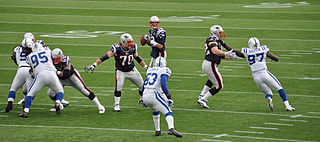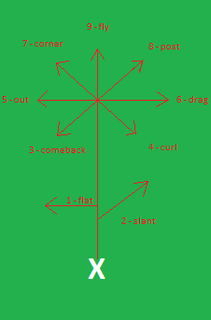
A cornerback (CB) is a member of the defensive backfield or secondary in gridiron football. Cornerbacks cover receivers most of the time, but also blitz and defend against such offensive running plays as sweeps and reverses. They create turnovers through hard tackles, interceptions, and deflecting forward passes.
In American football, the West Coast offense is an offense that places a greater emphasis on passing than on running.
A screen pass is a play in gridiron football consisting of a short pass to a receiver who is protected by a screen of blockers. During a screen pass, a number of things happen concurrently in order to fool the defense into thinking a long pass is being thrown, when in fact the pass is merely a short one, just beyond the defensive linemen. Screens are usually deployed against aggressive defenses that rush the passer. Because screens invite the defense to rush the quarterback, they are designed to leave fewer defensemen behind the rushers to stop the play.
A draw play, or simply draw for short, is a type of American football play. The draw is a running play disguised as a passing play. It is the opposite of a play-action pass, which is a passing play disguised as a running play. The play is often used in long yardage situations.
In gridiron football, blitzing is a tactic used by the defense to disrupt pass attempts by the offense. During a blitz, a higher than usual number of defensive players will rush the opposing quarterback, to try to tackle the quarterback or force him to hurry his pass attempt.
Strategy forms a major part of American football. Both teams plan many aspects of their plays (offense) and response to plays (defense), such as what formations they take, who they put on the field, and the roles and instructions each player are given. Throughout a game, each team adapts to the other's apparent strengths and weaknesses, trying various approaches to outmaneuver or overpower their opponent in order to win the game.

A flea flicker is an unorthodox play, often called a "trick play", in American football which is designed to fool the defensive team into thinking that a play is a run instead of a pass. It can be considered an extreme variant of the play action pass and an extension of the halfback option play.

The passing pocket, or the pocket, is a term used in American football to describe the area in the backfield created on a passing play where the offensive line forms a wall of protection around the quarterback. This allows him adequate time to find an open receiver and to pass the ball. The offensive line will drop back slightly, creating a U-shaped protected area for the quarterback to find an open receiver and pass the ball.
A trick play, also known as a gadget play, gimmick play or trickeration, is a play in gridiron football that uses deception and unorthodox tactics to fool the opposing team. A trick play is often risky, offering the potential for a large gain or a touchdown if it is successful, but with the chance of a significant loss of yards or a turnover if not. Trick plays are rarely used not only because of the riskiness, but also to maintain the element of surprise for when they are used.

In American football each team has 11 players on the field at one time. The specific role that a player takes on the field is called their position. Under the modern rules of American football, teams are allowed unlimited free substitutions; that is, teams may change any number of players after any play, at any point in the game. This has resulted in the development of three task-specific "platoons" of players within any single team: the offense, the defense, and the so-called 'special team'. Within these three separate "platoons", various specific positions exist depending on what each player's main job is.

Slotback, sometimes referred to as an A-back or, especially in the United States, slot receiver, is a position in gridiron football. The "slot" is the area between the last offensive lineman on either side of the center and the wide receiver on that side. A player who lines up between those two players and behind the line of scrimmage is a slotback. The position is a fixture of Canadian football and indoor football, but is also used in American football. The slotback is similar to the wide receiver but also has many of the same traits as a running back or tight end; a slotback lines up closer to the offensive line and often farther back than a wide receiver.

A slant route is a pattern run by a receiver in American football, where the receiver runs up the field at approximately a 45-degree angle, heading to the gap between the linebackers and the linemen. Usually, the pass is used when the corner or nickelback are playing farther away from the receiver, so a quick pass is able to be completed before the defender has time to try to break up the pass. The pass is used frequently in the West Coast system, where quick, accurate throwing is key. This route is most commonly used to exploit the cover 2 defense. Usually throwing in the seam between the safety and the cornerback is the key to getting a completion using this route.
In American football a play is a close to the ground "plan of action" or "strategy" used to move the ball down the field. A play begins at either the snap from the center or at kickoff. Most commonly plays occur at the snap during a down. These plays range from basic to very intricate. Football players keep a record of these plays in their playbook.
A hot route is a short passing route in American Football used to escape a potential sack from a blitzing defense.
In American football, Air Coryell is the offensive scheme and philosophy developed by former San Diego Chargers coach Don Coryell. The offensive philosophy has been also called the "Coryell offense" or the "vertical offense".

Zone coverage is a defense scheme in gridiron football used to protect against the pass.

A wheel route is a pattern run by a receiver or running back in American football. If a receiver runs it, they will immediately run a quick out pattern, then proceed to turn upfield in a curved pattern. Typically this route is run by an inside receiver, with the number one receiver heading inside to exploit coverage in the defense. When run from the running back position the player will run towards the sideline while looking back at the quarterback as if about to receive a pass on a flare route. The running back will then turn upfield at the sideline and run straight down the field.
The following terms are used in American football, both conventional and indoor. Some of these terms are also in use in Canadian football; for a list of terms unique to that code, see Glossary of Canadian football.
A play calling system in American football is the specific language and methods used to call offensive plays.

A route is a pattern or path that a receiver in gridiron football runs to get open for a forward pass. Routes are usually run by wide receivers, running backs and tight ends, but other positions can act as a receiver given the play.









